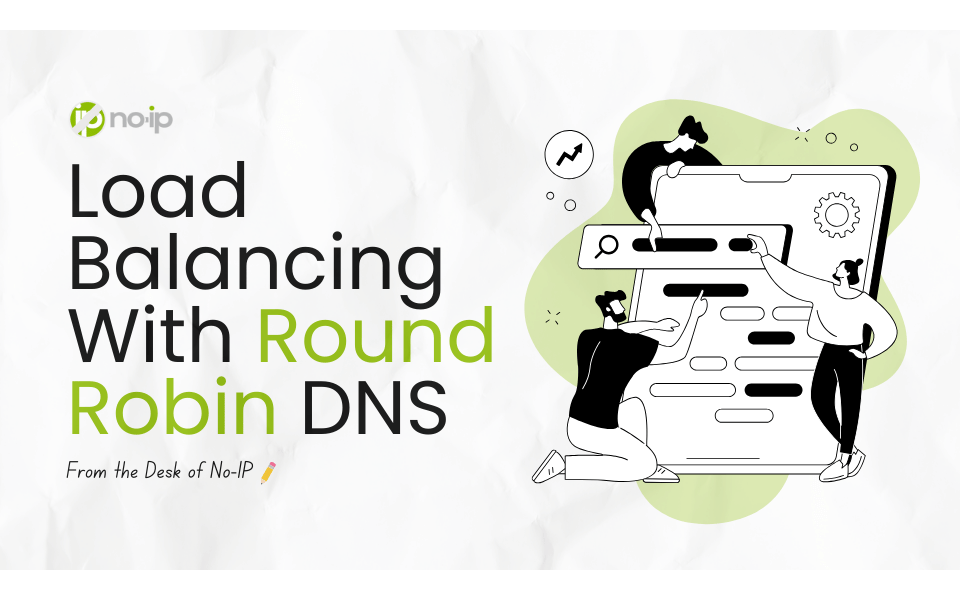
The Domain Name System (DNS) is effectively the internet’s phonebook. It translates domain names into IP addresses so users can access the sites they’re looking for. However, when traffic surges, a single server can get overwhelmed, leading to slow load times or worse, an outage.
Keeping your website or application online during these spikes can feel like a high-stakes balancing act, and in many ways, it is. Thankfully, though, there’s a simple and cost-effective solution for load balancing: A round robin DNS.
A DNS round robin configuration distributes traffic across multiple servers as a means of boosting uptime and keeping your digital presence consistent. At No-IP, we make it easy to set up and manage the round robin records with our managed DNS services. Let’s explore how you can use it to keep your site or app running smoothly.
What Is Round Robin DNS?
Round robin DNS strategies distribute incoming traffic across multiple servers by assigning different IP addresses to a single domain name in a rotating order (almost like a casino dealer passing out cards evenly to players). Each address gets its share of requests. When a user visits your site, the DNS hands out a request to one of the listed IP addresses, then moves to the next for the following request.
For example, let’s say your domain is tied to three servers, and you are using round robin DNS load balancing. One visitor will be sent to the first IP, another visitor to the second, and a third visitor to the third. The exact order of IPs will change, but the pattern repeats. The fourth user to visit your site will be sent to one of the three IP addresses, and the cycle continues. That kind of rotation prevents any single server from getting swamped.
How Round Robin DNS Helps With Load Balancing
By evenly cycling through IP addresses, round robin DNS load balancing reduces latency and prevents server crashes during traffic spikes. Such resiliency is crucial for websites, apps, or services that need to stay responsive under moderate to high loads.
Additionally, whereas complex load-balancing strategies require supplemental hardware or software, the DNS round robin configuration doesn’t require any kind of extra infrastructure. As a result, it’s a budget-friendly choice for small to medium-sized businesses.
If you’re interested in learning more about the ins and outs of the way round robin DNS distribution works, explore our knowledge base today. You can discover other tutorials, or learn about the different types of DNS records.
Configuring Round Robin DNS for Load Balancing
You can set up your DNS with a variety of host types. Depending on who you choose as your DNS provider, the process could look a little different. Here’s a quick breakdown of how to configure round robin DNS:
- Choose the “Round Robin” type when creating or modifying a hostname.
- Add the different servers or locations you want to cycle through.
- There’s no need to manually add A/AAAA records if you’re using No-IP. No-IP handles the load balancing automatically.
- If you’re not using No-IP, you may need to manually add additional A or AAAA records for the same hostname.
You can make the setup process even easier by signing up for managed DNS services, like those offered by No-IP.
Key Advantages of Round Robin DNS
Round robin DNS strategies are a favorite thanks to their ease of use and efficacy. A few additional key benefits of the approach include the following:
- Cost-Effectiveness: Eliminates the need for expensive hardware
- Enhanced Reliability: Distributing traffic across servers minimizes downtime
- Quick Setup: Configure things in minutes with user-friendly tools
- Scalability: Add servers as your traffic grows to make your round robin cycle larger
Altogether, a round robin DNS approach is easier on your wallet than more complex setups and just as capable of helping you avoid unexpected downtime.
When Should You Use Round Robin DNS for Load Balancing?
You may want to consider the round robin DNS model for load balancing if your business runs any of the following:
- Websites With Consistent Traffic: People regularly visit your site to check out your blogs or browse products
- Game Servers: Round robin configurations balance player connections to reduce lag
- Small to Medium Apps: Applications with moderate user bases can maintain performance without complex infrastructure
If your site or service handles hundreds or thousands of daily requests, round robin DNS will keep your servers from faltering under pressure.
Limitations of Round Robin DNS
Round robin DNS isn’t a one-size-fits-all solution. Most notably, the approach is not suited for setups that require real-time server health monitoring. It doesn’t check server health at all, so it may send traffic to a downed server until your DNS records are updated. It also treats all servers equally, ignoring differences in capacity or performance, potentially resulting in uneven loads and inconsistent experiences for some users.
Additionally, DNS caching by resolvers or browsers can delay traffic rerouting, especially if you are using longer TTLs. These drawbacks make round robin DNS strategies less ideal for mission-critical or high-complexity setups. Be that as it may, its simplicity still makes it an appealing option to many users as a way of promoting reliable performance on a budget.
How No-IP Can Help With Round Robin DNS and Load Balancing
At its core, a round robin DNS strategy represents a smart and budget-friendly way to balance traffic and promote better uptime, and No-IP makes it effortless to implement. Our managed DNS services offer a reliable platform to configure and monitor your round robin setup. And for dynamic setups, our DDNS service keeps your records current, even if server IPs change.
With No-IP, you get intuitive tools, comprehensive support, and exceptional uptime. Sign up with us today!